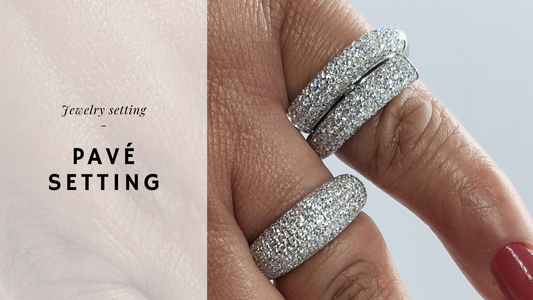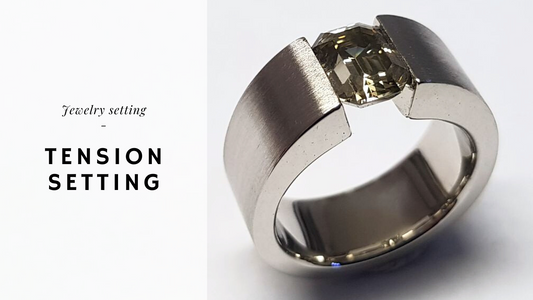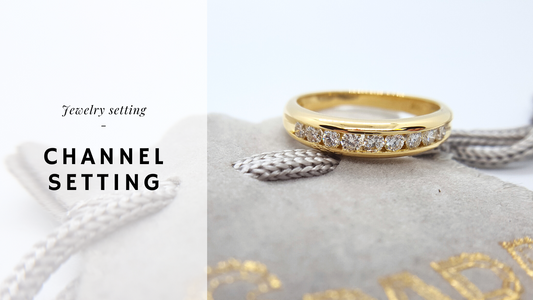
These frequently used terms describe the visual appearance of the interaction between light and a gem are often confused and misused, sometimes even by experienced industry professionals. The following clears up the confusion, allowing you to understand exactly what you are seeing when you gaze upon your gemstone jewelry.
Luster (external brilliance)
Luster is the quality and quantity of light reflected from a gem's surface and is a function of refractive index and surface perfection (degree of polish).
If nearly all the light falling upon a gem's surface is reflected, resulting in a very bright appearance, it is said to have high luster. If much of the light is absorbed b the gem, resulting in a dull reflection, it is said to have low luster. Luster is generally divided into two major categories: metallic and non-metallic.
Adjectives commonly used to describe luster include:
Metallic: This is a very high luster that has the appearance of polished metal. Hematite, pyrite and cuprite are examples of minerals that may exhibit this degree of luster.
Submetallic: This is used to describe minerals having the look of polished metal dulled by weathering or wear. Nearly-opaque gems that reflect well fall into this category. Sphalerite and cuprite often exhibit this type of luster.
Adamantine: This is the brightest, most reflective non-metallic luster. It is characteristic of gems with higher refractive indices (e.g., diamond and demantoid garnet).
Subadamantine: This term is used to describe gems that have a bright luster approaching that of diamond (e.g., certain varieties of zircon and garnet).
Vitreous: This luster is seen in polished glass and in most transparent gemstones whose refractive indices fall within the middle range of values (e.g., emerald and tourmaline).
Resinous: This luster is characteristic of certain gems with low-to-moderate refractive indices. It has the appearance of polished plastic. Amber exhibits resinous luster.
Silky: This type of luster is characteristic of certain gems that have an extremely-fine fibrous structure. Examples include ulexite, gypsum and malachite.
Pearly: As this adjective implies, it is descriptive of the luster seen in pearls and is used to describe any mineral or gem that has a similar appearance. Examples include muscovite, talc and the shell of various mollusks.
A common misconception is that high luster is better. Certainly for colorless gems such a diamond, this is the case, but for gems that depend on their color for beauty, a high luster is actually an impediment since it prevents light from entering the gem. This is why the colors of high refractive index (RI) gems, such as diamonds, are often somewhat "steely" while the colors of lower RI gems, such as emerald, can be so beautiful.

Brilliance
Brilliance refers to the amount of light returned to the eye from the interior of a gem and is mainly a function of refractive index, proportions and transparency. Faceted gems are designed to catch all possible light and throw it back to the eye. If the gem is cut too shallow, light from above and below passes straight through. This created a window where one can see through the gem. Thus, brilliance suffers.
Similarly, if the gem is cut too deep, light from above passes out the side. This creates areas of darkness, known as extinction. Again, brilliance suffers (and there's nothing worse than suffering brilliance).
A gem's potential brilliance is mainly a function of refractive index (RI), with higher RI gems having more potential brilliance. But as we learned with luster, a high RI can actually hurt the display of color. Thus, one should not worry too much about RI. The main thing to look for stones that are of good proportions-not too shallow, nor too deep. Overly-deep stones have the double disadvantage of being more difficult to set in jewelry.
It is important to note that gem cutting is an art form rather than a formula. What works best is simply what works best-that which brings out the greatest beauty in the gem. Since judgment of beauty is by definition subjective, quality of cutting is also a matter of opinion.

Fire
Fire is a manifestation of the optical property known as dispersion Dispersion occurs when light moves from one medium to another (e.g., air to gemstones). Each wavelength of light (i.e., red, orange, yellow, green, blue and violet) slows and is bent to a different degree. The result is that light no longer appears white. The effect is often demonstrated with the aid of a prism. In general usage, both terms are often applied interchangeably.
The effects of dispersion are probably best known in diamond; however, many gemstones with higher refractive indices also exhibit significant fire. Examples include cerussite, demantoid garnet and sphene.
Stones size and color can both affect fire. Larger gems are able to spread light to a greater degree because of the longer light paths. This helps dispersion. Color, as it becomes more intense, tends to mask the effect.



